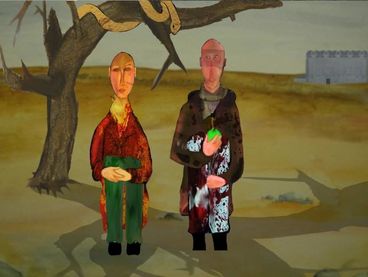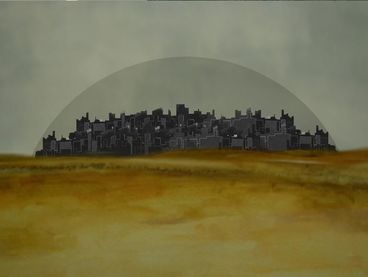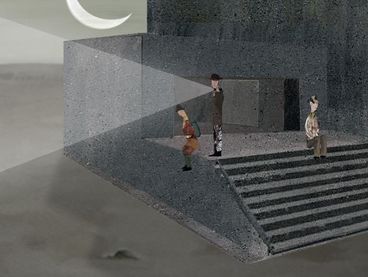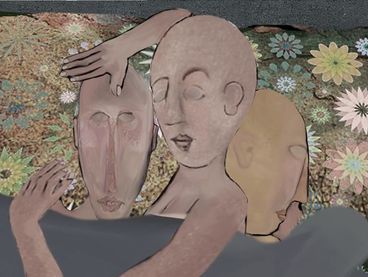MOOZ – audiovisual arts collection
The Animal That Can Lie
2012, 13 min., color
Idea, animation and direction: David Jansen
Storyboard and screenplay: David Jansen, Sophie Biesenbach
Sound design and mixing: Marcus Zilz
Advisors: Prof. Raimund Krumme, Kerstin Unger
Production: Academy of Media Arts Cologn
The 2012 animated film The Animal That Can Lie by David Jansen, made in collaboration with Sophie Biesenbach and Markus Zilz, was presented at filmkunstkino, on the occasion of the current development on his degree film project DÄWIT. This new film is also created in collaboration with co-illustrator Sophie Biesenbach.
In the beginning was the word. It contradicts any logic, just as you do to me when I say that we are free. For these hands I take no responsibility. These I have in fact inherited, good genes. In the end the innocent. The animal that can lie describes a world in which the silence of God is a burden and which has perhaps lost every context.
Interview with David Jansen
Your work is very interdisciplinary with drawing, watercolor, shooting on film, and telling very cinematic stories with tracking shots and perspectives. How would you describe your technique?
I’m coming from painting and from experimental film. I want to use the full range of technical possibilities that are available to me through my studies. In the beginning I worked straight from the gut, without any plan. During my studies, in the interest of efficiency, I had to reconsider this approach, which is still difficult for me. My desire that my work be understood by a wider audience is probably the reason to approach a theme more cinematically.
How did you start working in this style of animation?
I thought about how I could produce my films faster technically. In my own projects it doesn’t matter to me how developed the walk or turn of a character is. The usual animation nerd no-nos, like linear After Effects movements, don’t interest me. The style became something all its own and I have more time for other things.
Do you find a narrative form interesting?
More and more. My first works were very essay-like and thus too cryptic for a wider audience. I am aware of the power of strong stories. The form follows the content.
The sound is very important in your work. What does the sound do?
Sometimes I have the feeling that people forget that sound carries at least as much weight as the image. I say at least, because over the years I have gotten the feeling that sound perhaps plays an even greater role. Often filmmakers don’t dare to try something out at the level of sound and they stick with the standard sound design.
Animated films are often playful; yours seem dark, dreamlike, also violence appears again and again as a motif. What has influenced you in taking this direction?
Our real world. Like many other artmakers I am sickened by the absurdity of the world. When you’re young you are disdainful and make angry critiques. Then you ask deeper questions—not least about yourself. And then perhaps come the big crazy solutions. That’s the current state of affairs.
What’s next for you as an animation artist going forward?
During my studies at the KHM I found a production company with a screenplay and then also received a film grant. I realized this screenplay last year with Sophie Biesenbach as my debut DÄWIT. We just finished it. Otherwise I’ve taken a studio in an artists’ studio collective since I couldn’t stand to work at home anymore, which was one of the best ideas in the last years. We animators tend to get lonely. In collaboration with Marcus Zilz, my long-time sound designer, I’ve also founded a company. If things keep going in this direction, it would be great.
Text — Daniel Sondermann
David Jansen was born in 1980 in Wipperfürth. Undergraduate studies at the Academy of Media Arts, Cologne, from 2006 to 2013. Earned a degree in film and television with the animation Däwit.
More about David Jansen and his projects can be found here: www.sodakinda.com












